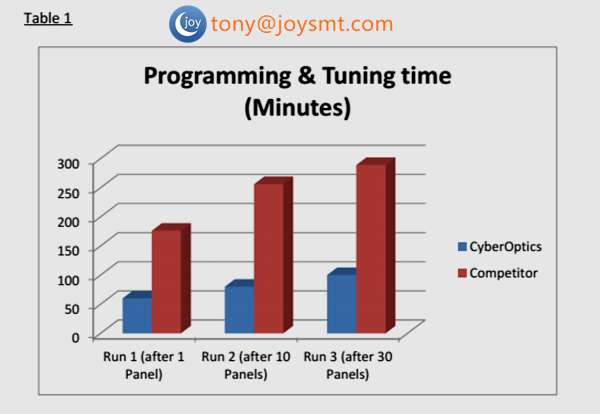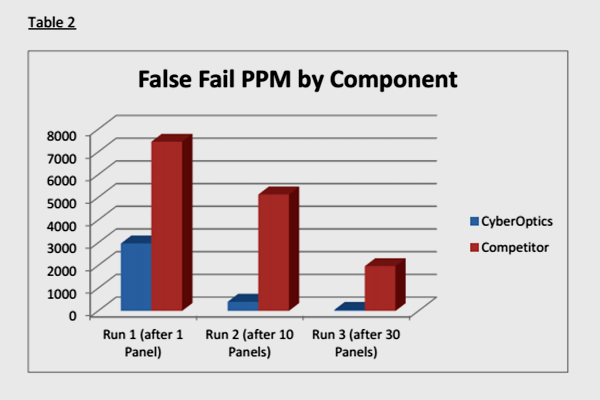Advanced modelling technique|SMT Technology
Advanced modelling technique achieves near to zero set up time and minimal tuning
Automatic Optical Inspection (AOI) is now an established solution for the reliable inspection of printed circuit boards (PCB’s) in the electronic manufacturing industry. AOI systems have developed considerably since their introduction in the mid 90’s, and now appear on most surface mount technology (SMT) production lines World-Wide. The majority of AOI systems utilize standard vision analysis technology in the form of multiple controlling algorithms and although there are many variations of this approach most are “programmed” and “tuned” in the same way. Modelling technology however is completely different in that it does not use a standard algorithmic approach but calculates process variation in real time on real production data by analysing pixel by pixel the image of the real production PCB. First conceived in the mid 1990’s and extensively developed since
Modelling [1] is based on Principle Component Analysis (PCA) and has many advantages for companies looking for a fast and versatile system that can be deployed to production very quickly and with the minimum of on-going production tuning.

Importance of fast set up & minimal tuning time
One of the key metrics when selecting AOI solutions is the total cost of ownership of the system once deployed to production. Programming time and production tuning time are major contributors to the on-going ownership costs hence should be measured and understood well in advance of production integration. In low volume / high mix applications set up time is even more important as the AOI program has to be ready and capable of reliable inspection before the production run is complete to have any real value. With production batch sizes below 20 x PCB’s this is very difficult to achieve on most algorithm systems.
Limitations of Algorithm technology approach for fast set up
Most algorithm technology systems are set up with the user having to anticipate the possible range of defects that could occur in production. The set up process includes selecting combinations of algorithms and setting their parameters in addition to those controlling image acquisition. This can be very time consuming with careful attention required to ensure everything is set up accurately.
Advantages of modelling technology for controlling process variation
Statistical Appearance Modelling technology is set up very easily and simply from an image of the first production PCB. The system “learns real world variation” based on operator interaction with the reported results of the inspection tasks. This results in a very accurate statistical description of the normal variation in the product. Using this description during inspection allows accurate reporting of what is acceptable and what is not acceptable to the user based on individual process or quality requirements. Clear advantages of this approach are that the user does not have to anticipate potential defects or process issues as the system will “flag” anything that is outside of the “normal production range” and secondly because the system is programmed with real production variation it is very sensitive to small subtle changes enabling very reliable defect detection. Recent developments to this technology include autonomous prediction of process variation which enables the AOI system to be set up from a single PCB with production ready performance. Set up time can
be as low as 15 minutes from data input to first PCB inspection making it extremely attractive for new product introduction (NPI) and first off verification.
Performance comparison of modelling technology versus Algorithm technology
The tables below are results taken from a recent production evaluation in the Automotive Industry. The PCB tested is a 6 up panel 300mm in length and 260mm in width with a total component count of 1380 and 73 individual component types. The inspection set up included tasks to reliably detect all component body, position, text, value, and solder joint related defects and the total individual inspection task count was 8,307
Table 1 below clearly illustrates a significant performance advantage of the modelling approach versus algorithm technology on this application with results of up to 3 x faster set up time for the modelling system. Of course a fast set up is only advantageous if the system can reliably inspect PCB’s afterwards with a very low false failure rate and provide some immediate value to the user

Table 2 below again illustrates a significant advantage from the modelling system when counting false failures after programming from 1, 10, and 30 panels. Again the modelling system was around 3 x lower in false failure rates.
AOI systems have developed considerably over the past twenty years and with the constant advances in computational technology there is no doubt that this pace of development will continue. Modelling technology is a key area of image analysis that is benefiting from these advances and is already a very attractive alternative to traditional algorithm technology when applied in SMT inspection.
With the ever increasing demand for faster set ups and improved inspection performance on a wide range of applications, statistical modelling technology is a very interesting and valuable solution especially where set up times and cost of ownership are critical to success.


